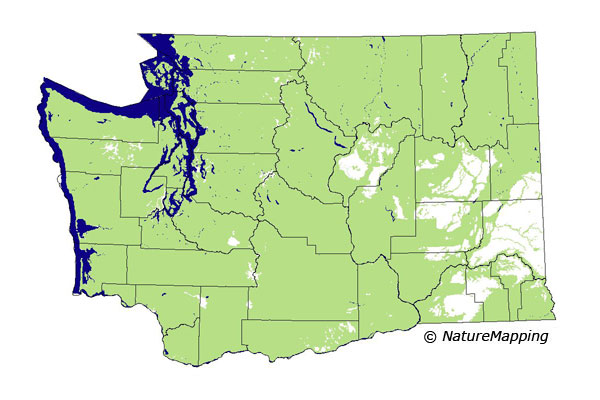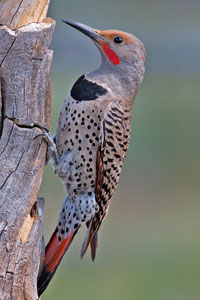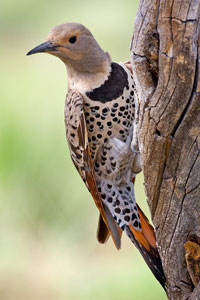


Northern Flicker (Colaptes auratus) What they look like: It is one of the only brownish woodpeckers and as it flies it can be recognized by a large white patch on its behind and the yellow under-surface of wings and tail. It has a black crescent on its breast and a patch of red at the back of its head. 
The male has a black streak along each side of the throat, while the female doesn't have the black streaks on the throat and the black crescent on the breast is smaller. Females are duller in color than the males. The Flicker has many round black spots on the sides, lower chest and belly. The rest of the chest is a reddish-white color spotted with black. (photo of a male on the left; female on the right) 
The flickers feet are short with two toes in front and two toes behind. The tail feathers are pointed at the tip which allows them to grip onto the bark of a tree for support (see photo). The strong bill is slightly arched and nearly as long as the head. It has worm-like tongue, with a hard sharp tip that can be extended far beyond the end of the bill to spear an insect in a hole. The body of the tongue is covered with sticky spit to capture ants and other small insects.
How big are they?
What they eat: It is commonly found on the ground where it will run a few steps and stop, run a few more steps and stop, until it finds an anthill. Ants are their most important source of food. One Flicker's stomach was found to contain more than 5,000 ants. It also eats a variety of other insects and wild fruit, especially wild cherries, dogwood, sumac and poison ivy. During the winter it is not afraid to visit suet feeders. Behavior: Spring is on its way when the loud joyful call of the flicker: "Wicker, wicker, wicker", echoes through the woodlands. Males are known for drumming in long continuous rolls made by rapid blows with his bill. Male Flickers will often return to their favorite drumming spot where most likely it is the loudest and noisiest spot. Nesting: A male flicker hollows out a cavity in a dead tree for nesting. The female will lay a bunch of eggs -- 5 to 8 -- called a clutch. Both the parents incubate the eggs for 11 days. The nestlings remain safely in the nest for 24 to 27 days, where both parents feed the young. After fledging, the young follow the parents for a few weeks to learn how to forage for food. [fledge = to develop the feathers necessary for flight] Did you know?
More information:
Northern Flickers - WDFW Living with Wildlife Animal silhouettes available to purchase » Photos by Natures Pics Home | About Us | How to Participate | Biodiversity Modules | Projects | Maps | News | Resources |